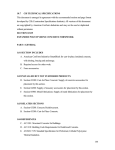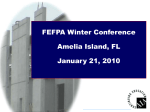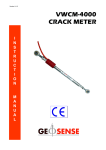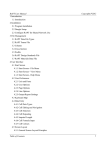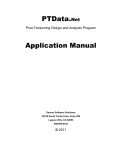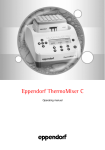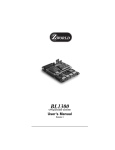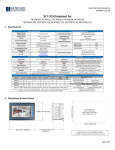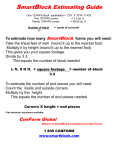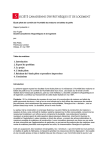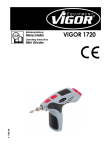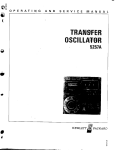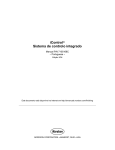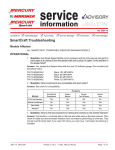Download Installation Manual - (ICF): SmartBlock Insulating Concrete Form
Transcript
THIS ON-LINE VERSION OF DESIGN & PRODUCT MANUAL DO NOT INCLUDE DESIGN DETAILS DRAWINGS NOR SUPPORTING REPORTS AND IS FOR REFERENCE ONLY. COMPLETE MANUAL IS AVAILABLE FOR DOWNLOAD FROM THIS WEBSITE OR WE CAN EMAIL IT TO YOU. SmartBlock™ Design and Product Manual August 2002 Edition TABLE OF CONTENTS EXHIBIT Chapter 1 INTRODUCTION 1.1 Introduction 1.2 What is EPS? PAGE 5 7 Chapter 2 SITE WORK AND FOUNDATIONS 2.1 Site Work - Monolithic Pours 2.2 Forming Fabrication 2.3 Foundation Systems 2.3.1 Slab on Grade 2.3.2 Stem Wall Foundation 8 8 9 8 10 Chapter 3 BUILDING WALLS 3.1 Footings 3.2 Reinforcing Steel 3.3 Ledgers 3.4 Lintels 3.5 Plates 3.6 Lateral Design 3.7 Structural Design 3.7.1 SF10 Series 3.7.1A Flexural Design Capacity 3.7.1B Allowable Lateral Loads 3.7.1C Allowable Axial Loads 3.7.2 VWF Series 3.8 Bracing Techniques 11 12 12 13 13 13 14 14 14 15 15 16 17 ii Chapter 4 INTERIOR FINISHES 4.1 Gypsum Wall Board 4.1.1 Horizontal Metal Strips 4.1.2 The SmartTach Anchor System 4.1.3 The SmartTach Installation Details 4.1.4 Other Attachment Methods 26 26 27 28 29 Chapter 5 DOORS & WINDOWS 5.1 Frames 5.2 Reinforcing Steel 30 31 Chapter 6 EXTERIOR FINISH MATERIALS 6.1 Below Grade Waterproofing 6.1.1 Liquid Emulsified Products 6.1.2 Sheet Goods 6.1.3 Acrylic Based Cements 6.1.4 Compatible Waterproofing Product List 6.2 Above Grade Exterior Finishes 6.2.1 Exterior Insulation Finish Systems 6.2.2 One Coat Stucco 6.2.3 Polymer Based Stuccos 6.2.4 Compatible Exterior Stucco List 6.3 Compatible Adhesive List 32 33 34 34 35 37 38 38 39 40 42 Chapter 7 PLUMBING AND ELECTRICAL 7.1 Introduction to Plumbing and Electrical 7.2 Plumbing 7.2.1 Direct Embedment 7.2.2 Protection of Pipes 7.2.3 Installation Recommendations 7.2.4 Support of Pipes 7.3 Electrical 43 43 43 44 44 46 46 Chapter 8 MANUFACTURERS SPECIFICATIONS 8.1 Manufacturers Technical Specifications 8.2 Energy Analysis 48 50 iii 8.2.1 8.2.2 8.3 8.4 8.5 8.6 8.7 8.8 SF10 Series VWF Series Sound Transmission Concrete Specifications Concrete Estimation Block Estimation Tools and Materials Radius Cut Outs Chapter 9 DESIGN DETAILS 9.1 Design Section Table A - Retaining Wall Chart (3’-6’) Table B - Retaining Wall Chart (8’) Table C - Retaining Wall Chart (10’) Table D - Stem Wall Foundations - Wood Frame Walls Table E - Full Height SmartBlock Walls 9.2 Detail Section 1.0 - Controlled Ventilated Crawl Space Detail 2.0 - Retaining Wall Detail 3.0 - Retaining Wall Detail 4.0 - Retaining Wall Detail 5.0 - Foundation Detail 6.0 - Foundation Detail 7.0 - Foundation Detail, Joist Running Parallel 8.0 - Foundation Detail, Joist Running Perpendicular 9.0 10.0 50 50 52 53 54 55 56 57 60 61 66 67 68 68 69 70 71 72 73 74 75 76 77 Foundation Detail, Interior Bearing Foundation, Joist Running Perpendicular 78 - Foundation Detail, Interior Bearing Foundation, Joist Running Parallel 11.0 - Full Height Wall Section, Two Story 12.0 - Ledger Detail, Flush Mounted 13.0 - Ledger Detail, Flush Mounted 14.0 - Lintel Detail at Eave 15.0 - Eave Detail, Rafter Running Parallel 16.0 - Eave Detail, Rafter Running Perpendicular 79 80 81 82 83 84 85 iv 9.3 17.0 - Gyp. Board Attachment Detail, Horiz. Metal Strip Method 18.0 - Window Detail, Head 19.0 - Chase Detail, 3” Vertical Drop at Ledger 19.0A - Section “A-A” Plumbing Chase Detail 20.0 - Electrical Placement 21.0 - Electrical Placement—Alternative View 22.0 - Corner Construction 23.0 - 4” Brick Veneer for 2x4 Stud Wall 86 87 88 89 90 91 92 93 Miscellaneous Details 94 Chapter 10 SUPPORT REPORTS 10.1 ICBO ES Evaluation Report No. 4572 10.2 BOCA Research Report No. 95-46 10.3 Wisconsin DILHR Material Approval No. 920083-I 10.4 Los Angeles Research Report No. 25006 10.5 Texas Department of Insurance – Product Evaluation FR-24 10.6 Structural Design Calculations for SF10 Series 10.7 CSI Technical Specifications 110 121 128 132 136 139 145 v Chapter 1 1.1 INTRODUCTION Introduction This manual introduces builders, contractors, architects and engineers to the design parameters and potential applications of SmartBlock insulating forms. SmartBlock insulating forms are expanded polystyrene (EPS) forms for pouring concrete loadbearing, shear and foundation walls. The forms are left in place after concrete is poured and provide superior insulation relative to conventional wood, concrete and masonry walls. The units are manufactured in two basic types, Standard Forms (SF10 Series) and Variable Width Forms (VWF Series). Both forms have rows of interlocking teeth at the top and bottom to facilitate easy assembly. The form units remain after placing of reinforcing steel and concrete and must be protected by approved interior and exterior finish materials. The SF10 Series units are 10 inches high by 10 inches wide by 40 inches long. The face shell thickness of the SF10 Series is 1¾ inches. When assembled, the units form 7½ inch by 6½ inch rectangular vertical cores at 10 inches on center and 6½ inch by 6¼ inch rectangular horizontal cores at 10 inches on center. The VWF Series units are 12 inches high by 40 inches long and can be assembled in varying widths providing concrete walls of 3¾ inches, 5¾ inches, 7¾ inches, 9¾ inches, 11¾ and other custom made widths. The average face shell thickness of the VWF Series is 2.125”. The facing walls of the form are interconnected with eight plastic bridge inserts. SmartBlock insulating forms are molded from EPS beads manufactured by BASF Corporation (ICBO Evaluation Report No. 3401) or Huntsman Chemical Corporation (NER-348), having a density of 1.5 to 2.0 pounds per cubic foot with a maximum flame-spread rating and smoke- 6 density of 10# and 250# respectively, in accordance with the 1991 Uniform Building Code (UBC) Standard No. 42-1. SmartBlock insulating forms are recognized by ICBO ES (Evaluation Report No. 4572), BOCA ES (Research Report No. 95-46), State of New York DHCR (Certificate No. 62493-MC), State of Wisconsin DILHR (Approval No. 980020-I), the City of Los Angeles (Research Report No. 25006) and various city and local building reports. All users of SmartBlock insulating forms should refer to the enclosed copies of evaluation reports and reports released after publication of this manual. These reports contain revised conditions related to the use of SmartBlock insulating forms and should be kept current by all users of the product. The manufacturer on request will provide updates, but use of SmartBlock insulating forms must be coordinated with local building officials. The design concepts within this manual use industry standards for most typical applications. Trade and material associations have been consulted to verify the workability of the product and to ensure that these assemblies address general field conditions. Since specifics vary depending on local conditions, it is imperative that the individual project architect or engineer review all details, specifications and calculations. Structural designs and calculations are based upon normal allowable forces and loads, and tables are included to show a variety of applications for SmartBlock insulating forms. Due to varying load conditions and building codes, each project should be reviewed and approved by the project architect or engineer. 7 1.2 What Is Expanded Polystyrene (EPS)? The use of EPS as formwork for concrete has a history in Europe dating back to 1950s. The use of EPS as formwork evolved from its use as an insulating material in construction. There are two common types of polystyrene foam, extruded polystyrene (popularly known by its Dow trademark Styrofoam) and expanded polystyrene or EPS. Most food service applications including meat trays, egg cartons, hamburger clam shells, foam plates and trays are extruded polystyrene, as are most types of loose-fill packaging. However, the common coffee cup is made of EPS. Almost all industrial cushion packaging - the cellular white molded foam that is used to package televisions, stereos, computers and delicate electronic equipment, as well as other fragile industrial and consumer products - is also of EPS, as are most bicycle helmets. Both EPS and extruded polystyrene are used extensively as thermal insulation in industrial, commercial and residential construction. As a raw material, EPS is produced in the form of white granules ranging in size from 8/1000ths to 12/1000ths of an inch. These granules, commonly referred to as bead or resin, feel something like very fine, polished sand. Three processing stages - prefoaming, intermediate storage and final foaming - turn the bead into rigid foamed plastic shapes, which in this case are SmartBlock insulating form units. Unlike extruded polystyrene, EPS contains no chlorofluorocarbons (CFC’s). EPS is inert and is less toxic than wood when burned. The EPS used in SmartBlock insulating forms contains fire resistant additives, which do not allow it to sustain a flame. 8 Chapter 2 2.1 SITE WORK AND FOUNDATIONS Site Work - Monolithic Pours Monolithic pour sites are prepared for construction of SmartBlock form walls in the same manner as for other common foundation forming systems. Set batter boards beyond all corners and stretch string lines across the location of the exterior faces of the walls. This procedure will locate the position of the corners. Using a plumb bob, set flag nails directly below the string at a distance of 4 to 6 feet apart, 1-foot from each corner. After completing the perimeter of the building, set a stake at each flag nail. Once the exterior stakes are in place, add an additional nail 1½” to the outside of the string location on the batter boards to offset the string. This will move the string out of the way for the next step and provide a wall alignment guide. Using stake material, build a spreader in an “L” shape: the bottom leg of the “L” should be 9¼” in length. Using the spreader, line up with the existing stake facing towards the interior of the building, setting interior rows of stakes directly opposite of exterior stakes. This setting of interior stakes will produce a ¾” toe-in that will hold SmartBlock insulating forms steady during pouring. 2.2 Forming Fabrication Once the stakes are set, bottom horizontal rebar may be set as needed to satisfy foundation construction requirements. Calculate the required form height by subtracting the sub floor and sill depths and mark elevation on stakes. Two courses of SmartBlock insulating forms can be assembled and slid between stakes to a point of minimum depth of spread footing and held in place by the toe-in of the stakes. Subsequent rows of forms can be added setting vertical and horizontal rebar as required. Once forms are in place to the required elevation, as marked on the stakes, and all rebar is in place, stakes should be held together at the top using SmartBlock box clips. The foundation should now be ready for inspection and may be poured upon approval. While pouring, use a 2” x 4” with the 1½” string offset to check wall for alignment. 9 At the contractor’s discretion, foundation hardware may be pre-clipped in place or set in concrete at pour. Pressure treated Douglas fir (PTDF) or foundation grade redwood sills should be placed and set while concrete is still wet. Note: The forms may also be set on pre-poured footings to form a foundation and/or above grade wall, much in the same manner as in conventional concrete block construction. 2.3 Foundation Systems This section addresses various foundation systems and analyzes design criteria for use of SmartBlock insulating forms with these systems. 2.3.1 Slab on Grade Slab on grade construction with SmartBlock insulating forms (see Details 5.0 - 10.0 from Chapter 16) is similar to construction of stem wall footings in conjunction with slab construction. Trenches are excavated and SmartBlock insulating forms are installed as described in Chapter 2.1. Design and construction of the wall is similar to design with masonry block. Build the SmartBlock insulating form wall following the recommendations in Chapter 3 with reinforcing steel placed in accordance with project requirements. The slab should be standard thickness with adequate base material as required by the soils engineer, with the vapor barrier extending the full length under the slab to prevent moisture penetration. 10 2.3.2 Stem Wall Foundation The use of SmartBlock insulating forms in stem wall foundations will reduce cost and improve energy efficiency especially when used for a controlled ventilated crawl space (CVC) or a perimeter insulated raised floor (PIRF) foundation system. See Detail 1.0 in Detail Section of Chapter 9. The relation between the size and location of all openings in stem wall foundations must be considered by the designer in relation to required lintel frames and other supporting elements. Crawl space openings must be framed as detailed for window openings, and reinforcement must be placed as shown in those details, considering any concentrated or point loads occurring in that locale. If vent openings are located in the wall, the same care should be taken for vertical loading as with larger openings. In all cases approved treated lumber such as PTDF or foundation grade redwood should be used in direct contact with concrete. When joists are running parallel to the foundation (Detail 7.0), use double joists nailed in accordance with the project documents. Inspect exterior joists for extreme size fluctuation (oversize) and warping to prevent accidental loading of this member. To insure proper wood coverage and workability of anchor bolts, it is recommended that a 2” x 6” minimum PTDF or foundation grade redwood sill be used. In situations where incidental retaining capacities are required of a stem wall footing, SmartBlock insulating form walls will perform as any other common concrete wall system. In these situations wall design should incorporate all conditions customarily considered in retaining wall design. The building walls (Chapter 3) and design detail (Chapter 16) chapters of this manual contain tables and design criteria, respectively, that will assist the design professional in determining retaining capacities meeting with local code and soil conditions. 11 Chapter 3: BUILDING WALLS This chapter addresses design aspects of the use of SmartBlock insulating forms in the construction of a building wall. SmartBlock SF10 insulating forms can be used in exterior or interior bearing or non-bearing walls to an unsupported height of 10 ft. for 2 story construction in accordance with Finding #2 of ICBO ES Evaluation Report No. 4572. Higher building walls can be constructed with the SmartBlock VWF Series forms or with the SF10 Series by specific design by an architect or engineer. This manual contains details and tables for use of SmartBlock SF10 Series insulating forms in building wall construction in accordance with ICBO ES Evaluation Report No. 4572, and BOCA Research Report No. 95-46. 3.1 Footings Building walls constructed with SmartBlock insulating forms require an increase in spread footings sizes compared with conventional wood frame construction, due to the increased weight of concrete walls. This increased size acts to and compensate for shear at the wall plane at the footing. In tables A, B, C, D and E in Design Section of Chapter 9, soil bearing pressures are assumed to be 1000 psf. Individual soils analysis may reduce or increase these sizes. 12 3.2 Reinforcing Steel Suggested reinforcing steel requirements, sizes and spacings are identified throughout in this manual. Reinforcement parameters should be in accordance with specific project design requirements. 3.3 Ledgers In typical reinforced concrete or masonry construction, floors are supported by the use of a ledger (see Details 6.0, 12.0 and 13.0). Before the pour, to avoid cantilevering the anchor bolts used in the ledger, the SmartBlock insulating forms should be cut to allow proper surrounding of "J" bolts with concrete. Due to the thickness of the concrete cell, embedment requirements should be addressed in all ledgers and ledger bolt designs. Horizontal diaphragm shear may be transferred to the wall at this point and should be designed for each project. To facilitate placement of reinforcing steel, all door and window openings should be constructed as fabrication proceeds rather than waiting until forming is complete. UBC requires that two No. 5 rebars are placed vertically and horizontally at each opening and the ends of the bars should extend a minimum of 24” beyond the corners of the opening. In the case of the restricted area past the corner of an opening, the bar may be bent to tie to the nearest horizontal or vertical reinforcing bar. 13 3.4 Lintels Lintels over openings may be constructed as shown in Detail No. 14.0. The distance between the top and bottom reinforcing steel governs the strength of the lintel so rebar placement is critical. If foam bridging in the SF10 Series restricts placement of rebar around lintels, VWF Series may be substituted. All lintel applications must be reviewed and approved by the project architect or engineer. 3.5 Plates The top plate may be installed in the same manner as common with other construction methods. The plate should consist of PTDF, foundation grade redwood or an approved equal. Due to shear forces at this level, anchor bolt spacings are designed depending on the size of plate used. Refer to table No. 25-F in the UBC for specific design parameters. Applications must be reviewed for compliance with local codes and conditions. 3.6 Lateral Design Lateral design is addressed in various details showing typical nailing, clips, anchor bolts, etc. used in the field for shear transfer (see Chapter 16 - Details 6.0, 7.0, 8.0, 9.0, 10.0, 12.0, 13.0, 15.0 and 16.0 ). These details show possible solutions that must be designed in connection with lateral design. Each project must be analyzed individually since specific building design and local codes govern parameters of lateral design. 14 3.7 Structural Design Unlike masonry walls that derive some structural value from concrete masonry units (CMU’s), the SmartBlock insulating form contributes no structural value to the wall system. The structural strength of SmartBlock insulating form walls is provided solely by the reinforced concrete structure contained within the SmartBlock insulating forms. 3.7.1 SF10 Series Section 10.6 of this manual contains a table of the allowable (factored) bending moments, lateral loads and axial loads of a concrete wall formed with SF10 Series insulating forms along with the supporting calculations for use by the design engineer and building officials. The structural design capacities of the 6½ inch wide concrete wall contained within the SF10 Series insulating forms are in accordance with Chapter 19 of the 1997 UBC. However, the structural capacity of the SF10 Series wall is slightly reduced (compared to a solid 6½ inch wide concrete wall) because of the displacement of concrete by the 2½ inch by 3½ inch EPS bridges spaced on a 10 inch by 10 inch grid pattern. 3.7.1A Flexural Design Capacity Since the 2½ inch wide EPS bridges in the SF10 Series block are spaced 10 inches apart horizontally, the effective width or “b” dimension of a SmartBlock insulating form wall is reduced 25% as compared to a solid concrete wall. Therefore, the “b” dimension per lineal foot of wall in the following equation: a = Asfy / .85f’ cb 15 is 9 inches in lieu of the standard 12 inch dimension customary for wall design. Once the modified “b” dimension is calculated, calculation of the allowable moment is identical to a solid concrete wall design using the following equation: fM = fAsfy (d - a/2) 3.7.1B Allowable Lateral Loads Similar to flexural design, the “b” dimension in the following equation: fV = f2Öf’c (b)d is 9 inches in lieu of the customary 12 inches for solid wall design. 3.7.1C Allowable Axial Loads For the 6½ inch wide wall, the presence of the EPS bridges effects the axial load capacity of the wall by reducing Ag in the following equation: fP = .55ff’cAg[1 - (Klc/32h)2] Ag for the SF10 Series wall is 58.5 square inches (6.5 inches x 9 inches) in lieu of 78 square inches (6.5 inches x 12 inches) for a solid 6½ inch wall. 16 3.7.2 VWF Series The VWF Series blocks are connected by plastic ties similar in size to ties used for conventionally formed concrete. Therefore, the structural capacities of walls using the VWF Series blocks are the same as for other concrete forming methods. These capacities may be calculated in accordance with Chapter 19 of the 1997 UBC for concrete wall widths of 3 ¾ inches, 5 ¾ inches, 7 ¾ inches, 9 ¾ inches and 11 ¾ inches. 17 3.8 Bracing Techniques Smart Block BRACING TECHNIQUES NOTE: The drawing represent possible methods of supplying alignment support for your Smart Block wall. They are intended to be use as guided only, and are not to scale. Proper support will vary depending upon site condition, concrete pressures, wall height, soil capacities and the overall building system being incorporated or architect for precise bracing requirements. 18 Corner Construction SF10 Series 19 Corner Bracing VWF Series Corner 20 Ladder Brace All Series 21 Arched Openings All Series 22 Corner Bracing VWF Series Corner 23 Mid Wall Bracing All Series 24 Window Bracing All Series 25 Door Bracing All Series 26 Chapter 4 INTERIOR FINISHES This chapter addresses the methods of attaching an approved 15 minute thermal barrier over SmartBlock insulating forms as required by Chapter 26 of the 1997 UBC. 4.1 Gypsum Wall Board All habitable areas of structures built with a SmartBlock insulating forms are required to be separated from the EPS by a thermal barrier having an index of 15. (See UBC Chapter 26.) The most common method is the use of gypsum wall board (GWB), also referred to as drywall. A minimum thickness of 1/2" is required to meet this condition. The 1997 UBC Chapter 25, which outlines the conventional methods of attaching drywall, requires that screws or nails be attached, as a minimum, 18" on center whether the drywall is attached horizontally or vertically. 4.1.1 Metal Clips At present, the UBC does not specifically address attaching drywall to SmartBlock insulating forms. The UBC does state, however, that a test can be used as an alternative to the standard methods of attachment for thermal barriers. SmartBlock insulating forms were tested using metal clips that provide mechanical attachment with the concrete and a fastening surface for drywall screws. 27 4.1.2 The SmartTach Anchor System SmartTach Anchor System is a fast, easy and secure way to attach gypsum wallboard, siding, lath, baseboard and other surfacing materials to SmartBlock™ walls. SmartTach Anchors are 20 gauge "L" shaped galvanized steel, with a 2-inch square plate connected to a tapered, 3.6-inch long insert that slides through the foam SmartBlock wall. Prior to the pour, in order to achieve mechanical attachment with the concrete, a minimum of four 20-gauge galvanized, 2" wide clips (sold under the product name SmartTach™) are imbedded, through SmartBlock, into the concrete. The drywall is attached to the SmartTach with 3/4" minimum self tapping drywall screws 12 inches on center. It is strongly recommended that drywall adhesive compatible with EPS be used to attach the remaining portion of the drywall to the SmartBlock insulating forms or additional screws at reasonable spacing. Finishing of the drywall, such as drywall tape and topping mud, should be done in accordance with conventional practice. SmartTach Anchors are pushed through the foam prior to pouring, and are held in place by the cured concrete. The system provides mechanical attachment of gypsum wallboard, siding, lath, baseboard and other surfacing materials once the concrete is in place. The SmartTach Anchor System is packaged in a box that contains 240 SmartTach Anchors. For more information about SmartTach anchors, see your local SmartBlock distributor or call 1-800-CONFORM 28 4.1.3 Instructions for installing SmartTach Step 1: Before pouring concrete, place a 1" daub of compatible adhesive on the back of the tab and install SmartTach 2" below the ceiling line 12" on center. Step 2: Place concrete in SmartBlock forms. The protruding tip creates a mechanical bond between the concrete and the SmartTach. Step 3: Apply compatible adhesive to the back of the wallboard in 3/8" continuous beads 8" on center, or in 2" diameter daubs 16" on center in each direction or as directed by your engineer or building official. Step 4: Install wallboard vertically and attach it to each SmartTach with minimum 1" long self-tapping screws. Finish wallboard with tape and joint compound as in conventional practice. 29 4.1.3 Other Attachment Methods Attaching drywall to the top wood plate instead of the metal strip described above should be sufficient to achieve the required thermal barrier. In order to achieve the required 15 minute thermal barrier over SmartBlock insulating forms as stipulated in Section 1713 of the 1991 UBC, you need only attach the drywall to the top strip. No other attachment is required although use of a drywall adhesive to assure a smooth and problem free surface is strongly recommended. 30 Chapter 5: DOORS AND WINDOWS This chapter describes the installation of doors, windows and crawl space access for structures built with the SmartBlock insulating forms. 5.1 Frames Doors and windows should be cut into the foam during installation of the SmartBlock insulating forms. Rough opening sizes must consider additional allowances for the frame described below. Door and window frames should be of 2” x PTDF, foundation grade redwood or other approved treated lumber. It is recommended that oversized frame material be used and “ripped-down” to desired size to eliminate any dead space between frame and finish material. One recommended frame attachment procedure is to use 3/8” diameter x 6” machine bolts in a staggered configuration leaving the nuts and washers on to resist pull-out of the bolts. The bolt heads shall be countersunk into the frame with a minimum amount of frame removed for a flush fit after washer and head are inlaid. An alternate method is to use ½” diameter x 8” anchor bolts set so the nut and washer will inlay flush at the frame with care taken so as not to allow the end of the bolt to extend beyond the face of the frame. See Detail 18.0. 31 5.2 Reinforcing Steel Reinforcing steel is required to surround all openings in the following manner: 2-#5 reinforcing steel bars are required both horizontally and vertically around all openings, and must extend a minimum of 24” beyond the corner of that opening. In the case of the restricted area past the corner of an opening, the bar may be bent to tie to the nearest horizontal or vertical reinforcing bar. 32 Chapter 6 EXTERIOR FINISH MATERIALS The exterior, both above and below grade, of SmartBlock insulating forms must be covered with a protective and waterproof finish after the reinforcing steel and concrete have been placed. This chapter describes exterior finishes that may be applied to SmartBlock insulating forms. 6.1 Below Grade Waterproofing SmartBlock insulating forms must be waterproofed in below grade applications. Section 6.1.4 contains an approved list of waterproofing products for SmartBlock insulating forms. SmartBlock insulating forms absorb only 2% by volume in water. In addition, water vapor transmission allows water to flow through the block. In a below grade structure, water vapor transmission will damage the interior drywall, causing it to warp and discolor. In the case of a retaining wall, water vapor transmission caused by inadequate waterproofing will cause the stucco on the exterior to discolor and possibly to spall off the wall. EPS is a petroleum by-product that will dissolve when placed in contact with solvents, keytones, esters, and pitches. It is very important when selecting a waterproofing product that it is checked for compatibility with EPS. If you are concerned with the compatibility of a waterproofing product with EPS, call your material distributor or take a small portion of the product and apply it to a section of a SmartBlock insulating form. If you notice any disfigurement of the EPS (shrinkage, warping, etc.) within 24 hours, select a different waterproofing product. There are many waterproofing products that work well with SmartBlock insulating forms. Most waterproofing failures are due to improper application, so waterproofing should be applied according to the manufacturers’ instructions. 33 Waterproofing must be applied thoroughly to cover the SmartBlock insulating form wall leaving no holes or voids. Any pinholes or voids will permit moisture to infiltrate the wall. Particular attention should be given to assure that the joints and seams of the forms are sealed. There are three common types of waterproofing used on EPS: Liquid emulsified products, sheet goods (membranes) and acrylic based cementitious products. 6.1.1 Liquid Emulsified Products Liquid emulsified products work well in confined work spaces. The surface of the SmartBlock insulating forms must be clean and thoroughly dry before the waterproofing is applied. To test for dryness, tape a 4” square of aluminum foil to the EPS surface of the form being sure to tape the perimeter edges completely to prevent moisture escape. Allow the foil to remain undisturbed for 24 hours. Remove the tape carefully, and turn over the aluminum foil. If moisture is present on the foil then the surface requires additional drying. After thorough application of waterproofing (this may require 2 coats), protection board, usually ¼” extruded polystyrene, must be applied over the waterproofing. This is required to prevent damage to the waterproofing material during backfilling. Waterproofing should be applied to a minimum of 6” above the planned finish grade in all applications. 34 6.1.2 Sheet Goods Sheets goods also provide an effective method of waterproofing. The EPS exterior of the SmartBlock insulating forms must be clean and thoroughly dry, as required for liquid emulsified waterproofing. Sheet goods are placed on the wall, then the seams must be sealed with an adhesive strip. Do not use a system that requires the seams to be torch sealed as this may cause the SmartBlock insulating forms to melt. The same use and application of protection board is required as with the emulsified materials. 6.1.3 Acrylic Based Cements Cement products that contain acrylic bases are also commonly used for waterproofing. The application is the same as for emulsified materials except that this material may be colored and may be applied to the entire wall both above grade and below grade. The main benefit to this particular type of application is in its aesthetic appearance. However, because it is a cement product it does not have the same expansion and contraction and freeze thaw durability as the other methods. 35 6.1.4 Compatible Waterproofing Products—updated August 2002 NOTE: Any product that is certified by its manufacturer to be compatible with EPS, such as the products listed below, may be used with SmartBlock forms. American ConForm Industries makes no endorsement or guarantee for such products, or for the product listed below. MANUFACTURER Armtec Limited 33 Centennial Rd. Orangeville, Ontario CANADA L9W 1R1 519-942-2643 800-265-7622 Union Carbide Corp. 410 Gregson Drive Cary, NY 27511 (914) 345-5300 MULTICOAT Corp. 1565 Sunflower Ave. Costa Mea, CA 92626 (714) 754-1212 Fax (714) 754-8996 W.R. Meadows, Inc. 60 Teal Court P.O. Box 97 Benicia, CA 94510 (707) 745-6666 Crossfield Products 3000 E. Harcourt Street Rancho Dominguez, CA 90221 (310) 886-9100 Polyguard Products, Inc. P.O. Box 755 Ennis, Tx. 75119 (800) 541-4994 Protecto Wrap Waterproofing Membranes 2255 S. Delaware Street Denver, CO 80223 (303) 777-3001 The Quikrete Companies 1790 Century Circle NE Atlanta, GA 30345 (800) 282-5828 PRODUCT NAME Platon – Foundation Protector System DESCRIPTION Air gap plastic membrane used to protect any type of wall system bellow the grade BIPCO 40-W Watershield Acrylic Elastomeric Slatex System Above And Below Grade Waterproofing System Mel-Rol Membrane Waterproofing Liquid Emulsion Miracote Liquid Membrane Neoprene Emulsion Polyguard Membrane Waterproofing PROTECTO WRAP Membrane Quikrete Heavy Duty Masonry Coating #1300 Acrylic Based Cement 36 Surewall Producers Council W.R. Bonsal Co. (800) 334-0784 CA Distributor: Paragon Building Products 111 N. Vineland City of Industry, CA 91746 (818) 333-2217 Western Stucco Prod. Co. Inc. P.O. Box 968 6101 North 53rd Drive Glendale, AZ 95311 (623) 937-9141 La Habra Stucco 1631 W. Lincoln Ave. P.O. Box 3700 Anaheim, CA 92803 (714) 754-1212 WR Grace & Co. 14901 N. Scottsdale Rd.306 Scottsdale, AZ 85254 (800) 852-0568 Highland Stucco and Lime 15148 Oxnard Street Van Nuys, CA 91411 (818) 785-3131 Armtec Limited 33 Centennial Rd. Orangeville, ON L9W 1R1 (519) 942-2643 (800) 265-7622 Surecoat Acrylic Based Cement WESTERN ONE KOTE Stucco System Acrylic Based Cement Krete Kote Acrylic Based Cement Bituthene System 4000 Membrane Waterproofing WIRE TEX Stucco System Acrylic Based Cement BIGO Drainage mat – air gap membrane This list is only a portion of the products you could use. If the material is not listed, check with the manufacturer for compatibility and installation instructions. 37 6.2 Above Grade Exterior Finishes This section describes recommended stucco finishes and coatings for use with the SmartBlock insulating forms. See Section 6.2.4 for stucco list. 38 6.2.1 Exterior Insulation Finish Systems The first group of coatings are generically known as Exterior Insulation Finish Systems (EIFS). These systems are designed specifically for exterior EPS construction. The installation sequence for all EIFS coatings is as follows: 1) Liquid acrylic is mixed with common cement and applied to the EPS surface as a base coat. 2) Fiberglass mesh with ¼” grid is embedded into the base coat. 3) Colored liquid acrylic of varying textures is applied as a finish coat. The average thickness of EIFS coatings is 1/8”. These systems have color fastness for up to ten years and are highly resistant to freeze-thaw conditions. In addition they provide a waterproof coating due to the acrylic additives. The main disadvantage of these systems is their low impact resistance to puncture. As a result, these coatings are often installed away from high traffic areas. EIFS coatings also tend to be more expensive than other finishes. 6.2.2 One Coat Stucco “One coat stucco” is designed for use on exterior EPS construction. The installation sequence for one coat stucco finishes is typically as follows: 1) Apply pre-mixed base (cement, sand, and cut (approx. 3/8”) acrylic fibers) to the EPS surface with either a trowel or plaster application gun. 2) Fiberglass mesh, with a ¼” wide grid may be imbedded in the base in areas of high traffic (below 6’). 3) Apply desired pigment box, also known as color packs, over the base to achieve desired color finish. 39 The average thickness of these systems is 3/8” to ½”. These finishes have high impact resistance, are very easy to apply and allow for many texture variations. 6.2.3 Polymer Based Stuccos Direct liquid or polymer type additives are poured directly into a cement, sand and lime brown coat mixture. The installation procedure is as follows: 1) Combine cement, sand and lime per manufacturer’s specification in standard cement mixer or plaster application gun. 2) Add specified amount of liquid polymer per manufacturer’s specification in order to insure proper chemical bonding of cement base coat to EPS surface. 3) Fiberglass mesh, with ¼” wide grid may be applied in areas of high traffic (below 6’). 4) Finish in stucco-like textures, as required. 5) Apply finish coat of color integral stucco or paint with acrylic exterior paint. The average thickness of this system is 3/8” to ½”. These products are very easy to apply, have very high impact resistance, especially with applied mesh, and provide a solid waterproof coating due to the polymer additives. 40 6.2.4 Compatible Exterior Stuccos—updated September 2000 NOTE: Any product that is certified by its manufacturer to be compatible with EPS, such as the products listed below, may be used with SmartBlock forms. American ConForm Industries makes no endorsement or guarantee for such products, or for the product listed below. E.I.F.S. are Exterior Insulated Finishing Systems. MANUFACTURER OMEGA PRODUCTS CORP.2041 S. Susan Street P.O. Box 156 Santa Ana, Ca. 92704 (714) 556-3830 EXPO STUCCO PRODUCTS7465 Carrol Road San Diego, CA 92121 (619) 566-4343 DRYVIT SYSTEMS P.O. Box 539 Woodlake, CA 93286 (800) 556-7844 EL REY STUCCO COMPANY 4100 1/2 Broadway SE Albuquerque, NM 87102 (505) 873-1180 MULTICOAT CORP. 1565 Sunflower Ave. Costa Mesa, CA 92626 (714) 754-1212 MERLEX STUCCO MANUF. 2911 N. Orange-Olive Rd. Orange, CA (714) 637-1700 PERMA•CRETE501 Metroplex Drive, Suite 115 Nashville, TN 37211 (615) 331-9200 PRODUCT AKRO FLEX OMEGA STUCCO DIAMOND WALL TYRO BOND TYPE E.I.F.S. One-Coat Acrylic Based Stucco WALL BOND FIBER WALL E.I.F.S One-Coat DRYVIT E.I.F.S. INSUL-FLEX E.I.F.S. KRETE KOTE INSUL-STUCCO MULTICOAT STUCCO E.I.F.S. Acrylic Based Stucco MERLEX STUCCO E.I.F.S. PERMA•CRETE Acrylic Based Cement 41 LA HABRA STUCCO1631 W. Lincoln Ave. P.O. Box 3700 Anaheim, CA 92803 (714) 774-1186 QUIKRETE 1790 Century Circle NE Atlanta, GA 30345 (404) 634-9100 PARAGON BUILDING PRODUCTS, INC.111 N. Vineland Ave.City of Industry, CA 91746 (909) 549-1155 THORO SYSTEM PROD.7800 N.W. 38th StreetMiami, Fl. 33166 (800) 243-6739 US GYPSUM CO. 550 N. Brand Blvd. 12th Floor Glendale, CA 91203-1904 (909) 941-8850 WESTERN STUCCO PROD.P.O. Box 9686101 North 53rd Drive Glendale, AZ 95311 (623) 939-9455 HIGHLAND STUCCO 15148 Oxnard Street Van Nuys, CA 91411 (818) 785-3131 KING STUCCO CO. 1631 S. 10th Street San Jose, Ca. 95112 (408) 293-4008 POLY BOND LA HABRA ONE COAT Acrylic Based Cement One-Coat QUIKWALL Acrylic Based Cement SUREWALL SURFACE BONDING CEMENT SURECOAT MASONRY COATING Acrylic Based Cement THOROWALL E.I.F.S. USG EXTERIOR FINISH SYSTEM E.I.F.S. WESTERN ONE KOTE One-Coat Acrylic Based Cement WIRE TEX One-Coat Acrylic Based Cement XL Coat E.I.F.S. 42 6.3 Compatible Adhesive List--updated July 1999 NOTE: Any product that is certified by its manufacturer to be compatible with EPS, such as the products listed below, may be used with SmartBlock forms. American ConForm Industries makes no endorsement or guarantee for such products, or for the product listed below. PRODUCT #77 Spray Adhesive MANUFACTURER NOTES 3M Corporation Spray (612) 736-3238 (800) 480-1704 ACE Construction ACE Hardware Mastic Adhesive (800) 347-4583 DAP 2000 Construction DAP Inc. Mastic Adhesive 855 N. Third Street Dayton, OH (800) 543-3840 Enerfoam Abisko Manufacturing, Foam Adhesive System Inc.Richmond Hill, Ontario Canada, L4B 1E4 (800) 567-4447 ex. 43 Franklin Multi-Bond Franklin International Mastic Solvent Free Bruck Street Columbus, OH (800) 877-4583 (614) 443-0241 PL300 Chemrex, Inc. Mastic PL Premium 889 Valley Park Drive Shakopee, MN 55379 (800) CHEMREX MD 200 Macklanberg-Duncan Mastic 4041 N. Santa Fe Oklahoma City, OK 73118 (800) 654-8454 (405) 528-4411 Miracle DSA 40 Pratt & Lambert Specialty Mastic Prod.75 Tonawanda StreetBuffalo, NY 14207 (800) 876-7005 This list is only a portion of the products you could use. If the material is not listed, check with the manufacturer for compatibility and installation instructions. 43 Chapter 7 7.1 PLUMBING AND ELECTRICAL Introduction to Plumbing and Electrical Consideration of support services such as plumbing and electrical systems from the preliminary schematics phase through final construction, including regard for ease of installation, cost and future access requirements, can avoid many construction problems. Structural systems can be modified and interior chases and soffits can be incorporated to provide space and access necessary for years of satisfactory service. SmartBlock insulating form concrete walls share the same attributes as other solid masonry wall systems and must incorporate many of the same construction practices. The following sections contain suggested methods to facilitate the installation of plumbing and electrical systems in SmartBlock insulating form walls. All design parameters must obey the rules of all applicable codes and regulations for all governing authorities having jurisdiction over the project. 7.2 Plumbing 7.2.1 Direct Embedment Design parameters for pipes in SmartBlock insulating form concrete walls are similar to the design parameters for pipes in other solid masonry walls. Most building codes prohibit direct embedment of pipes in concrete walls and foundations to avoid damage from expansion and contraction of hot water pipes and from expansion, contraction and settlement of structural systems. 44 7.2.2 Protection of Pipes Code compliance through varying methods of protecting piping from the results of expansion, freezing and structural stresses is generally interpretative. Suitability of any particular method should be verified by local building officials during the design phase. Some methods now in use, although legal in some jurisdictions, are not recommended by the manufacturer. Included, by example, would be wrapping pipes in layers of building paper or any other method that would restrict future access to that pipe. Some of these methods may be suitable for commercial applications, but would be inappropriate in residential construction. 7.2.3 Installation Recommendations The details in this manual should serve most conditions and are configured to show “extreme case” installation requirements. See Details 19.0 and 19.0A. “Extreme case” in this instance is considered to be a 4” ABS soil line, running vertical past the floor ledger, assuming 5” across the hub. Note: The use of 4” cast iron soil pipe may require the structural abandonment of an entire vertical cell and specific engineering consideration would be necessary. To embed pipes in SmartBlock SF10 Series walls, chases should be cut through the foam blocks at the foam bridges. This method maintains the structural integrity of the vertical cell and horizontal bond beam at the floor level. (This wall section should be shored until the concrete is cured.) This location provides maximum concrete retention in the vertical cells and will not affect the location of vertical reinforcing bars. The benefit of this system is that exact pipe location is not necessary at the time of setting the vertical foundation reinforcing, as would be, if an entire vertical cell were eliminated. When using this system for large pipe, a vertical section of foam is removed to house a portion of the pipe. Since floor ledgers are inset into the foam and secured directly to the concrete, vertical pipe runs conflict in this area. Ledgers may be 45 notched at this location, provided structural analysis has been performed as with any alteration of structural support elements. Doubling the anchor bolts at either side of the notch should be sufficient, although confirmation should be sought by the project architect or engineer. Location of any structural reinforcing or fastening members in relation with the chase shall be verified to meet all structural requirements as to clearances, embedment, continuous application, etc. Insulation of pipes in exterior walls may be required to protect pipes from freezing. The remaining layer of polystyrene foam at the exterior may be sufficient to prevent freezing in milder climates. Insulation of pipes may also be desired to dampen sound transmission. In most cases, foam insulation fit onto the clearance space of the chase should be sufficient to reduce noise and should not effect free movement of the pipe. These considerations should be addressed with local building officials before application. Installation of smaller pipes, including copper supply lines, may be channeled directly into the foam. This is accomplished by using a router or heat tool to cut enough foam out providing a channel of sufficient width and depth to house the pipe. When using this system, pipes must be protected from mechanical damage. This may be accomplished by providing a section of metal strap, no less than 1/16” thick, over the channel after the pipe is secured. 46 7.2.4 Support of Pipes All pipes shall be supported as required by local codes, considering pipe alignment and the weight of the piping and contents. Since pipes are to be installed after concrete is set, support must be of an approved concrete fastening system. Drilled concrete screw type anchors are recommended, although any approved concrete fasteners may be used. Power actuated nails are not recommended with SmartBlock SF10 Series forms due to the possibility of firing pins through the foam bridges. 7.3 Electrical Electrical wiring can easily be placed into walls built with SmartBlock insulating forms. Place deep concrete junction boxes through the wall of the form at desired locations prior to pouring concrete. This will allow for the mechanical attachment of the box to the concrete. Also prior to pouring, run conduit to the primary junction boxes from the future location of the joist bay above. The junction box will also serve as the switch location for the room’s “half hot” plug or ceiling mounted fixture. Check with local building department for specific sizes and requirements. From the junction box, one Romex wire will be used for the switch and “half hot” plug; another for the other electrical outlets required in the room. After the pour, these wires can be placed in chases cut into the wall of the forms from the main junction box. Create a chase for the Romex with a router or heat tool (a heat tool is faster, cleaner and more accurate) making larger cut outs at the desired locations for the outlets. If holding a straight line is difficult with the router or heat tool, snap a chalk line to follow a course. 47 To protect the Romex from nails or screws, a number of methods may be used. One method is to cover the Romex with a minimum 16 gauge continuous “C” channel pressed flush with the surface of the SmartBlock insulating form. As an alternative, if the foam is cut out to a minimum of 1½”, the Romex can be glued in place with an adhesive or spray foam applied every 24” on center. You can also replace the cut out foam piece over the Romex, pressing or rasping the foam flush with the wall, so the Romex will not back out of the slot. Either method will give a minimum 1½” protection, after addition of the drywall, to properly protect it from any penetration. When using SF10 Series forms, locating outlet boxes on the bridges after concrete placement will permit use of a deeper box. If boxes cannot be located on the bridges or if VWF Series forms are installed, a shallow outlet will be required. See Detail 20.0 on page 88. 48 Chapter 8 8.1 MANUFACTURERS SPECIFICATIONS Manufacturers Technical Specifications Property Part Size Test or Standard Average EPS Wall Thickness Concrete Wall Thickness Color Insulation Value ASTM C-236 Fully grouted ASTM C-177 ASTM C-518 ASTM C-177 ASTM C-518 ASTM C-177 ASTM C-518 ASTM C-177 ASTM C-518 ASTM C-177 ASTM C-518 STC Rating (inc. 2 layers 1/2" Gypsum drywall) Flame Spread Product SF10 12VWF4 12VWF6 12VWF8 12VWF10 12VWF12 SF10 VWF SF10 Value 10" x 10" x 40" 8" x 12" x 40" 10" x 12" x 40" 12" x 12" x 40" 14” x 12” x 40” 16” x 12” x 40” 1.75" 2.125" 6.5" 12VWF4 12VWF6 12VWF8 12VWF10 12VWF12 EPS forms VWC4 VWC6 VWC8 VWC10 VWC12 SF10 3.75" 5.75" 7.75" 9.75” 11.75” Light gray Yellow Blue Red Black Grey 0.057 U R-22 Equivalent* 0.048 U R-24 Equivalent* 0.047 U R-24 Equivalent* 0.046 U R-24 Equivalent* 0.045 U R-24 Equivalent* 0.044 U R-24 Equivalent* STC-52+ STC-44+ STC-55+ STC-58+ STC-59+ STC-60+ 10 (5##) 12VWF4 12VWF6 12VWF8 12VWF10 12VWF12 SF10 VWF4 VWF6 VWF8 VWF10 VWF12 ASTM E-84 UBC Standard 42-1 49 Smoke Development Property 15 Minute Thermal Barrier Exposure in a crawl space SmartBlock EPS Specifications Flexural Strength Compressive Strength Density Shear Strength Tensile Strength Water Vapor Transmission Water Absorption Capillarity Coefficient of thermal expansion Flash ignition temperature Self ignition temperature Maximum Temperature BTU Content ASTM E-84 UBC Standard 42-1 45-125 (75##) Test or Standard UBC Standard 17-5, 1991 UBC Section 1713(d), 1991 UBC Section 1713(d)D, 1991 Product Value Compliance (UC Berkeley) Compliance (Southwest Research Institute) Value at 1.5 PCF Value at 2.0 PCF ASTM C-203 ASTM D-1621 ASTM C-303 ASTM C-273 ASTM D-1623 ASTM C-355 50psi 25psi 1.5 PCF 32psi 22psi 0.7-1.4 PERM/IN 75psi 33psi 2.0 PCF 37psi 27psi 0.7-1.4 PERM/IN ASTM C-272 ASTM D-696 <2% by volume None 0.000035 in/in/° F <2% by volume None 0.000035 in/in/° F ASTM D-1929 675 oF 675 oF ASTM D-1929 675 oF 675 oF 165 oF 165 oF 17,000 BTU/ lb. 17,000 BTU/ lb. ASTM D-2015 NFPA-259 *The R-value equivalent stated refers to a comparison of a SmartBlock insulating form wall versus wood framing 16" on center with the cavities filled with fiberglass batt insulation. This is the "standard" that is used when comparing R-values and thermal insulation factors for use with the various energy agencies. 50 8.2 Energy Analysis The following sections describe the insulation values that are associated with the SF10 Series and the VWF Series forms. 8.2.1 SF10 Series Because the SF10 Series form has integral EPS bridges, most of the state energy offices have required that the SF10 Series be tested in accordance with ASTM C-236. This is a total wall assembly test rather than the conventional method which tests each individual component. The wall has a tested U-value of 0.057 (A U-value is the inverse of an R-value when used as a total wall assembly.) The U-value of 0.057 exceeds all state and local insulation requirements for the entire United States for both above and below grade applications. It is the equivalent of a wood framed wall with studs 16” on center having the cavities filled with R-22 fiberglass batt insulation. In many cases this can qualify for insulation rebates. It is recommended that you check with your local power or utility company to determine if you are eligible for insulation rebates for using SmartBlock. 8.2.2 VWF Series Because the two side panels of the VWF Series are essentially flat pieces of EPS, ASHRAE values are used in calculating the insulation values. The value for 2.0 PCF density EPS is 4.40 R/inch. The average thickness of each panel is 2.125”. Therefore, each panel has a value of 9.35 R. They are 0.048 U for the VWF4, 0.047 U for the VWF6, 0.046 U for the VWF8, 0.045 U for the VWF10 and 0.044 U for the VWF12. 51 The U-values of 0.048, 0.047, 0.046, 0.045 and 0.044 exceed all state and local insulation requirements for the entire United States for both above and below grade applications. These values are the equivalent of a wood framed wall with studs 16” on center having the cavities filled with R-24 fiberglass batt insulation. In many cases this can qualify for insulation rebates. It is recommended that you check with your local power or utility company to determine if you are eligible for insulation rebates for over insulating your structure. 52 8.3 Sound Transmission Because SmartBlock insulating form walls are essentially concrete, they work very well as sound walls. The ratings for these walls are stated in terms of an STC (Sound Transmission Class). The minimum STC Rating for sound walls as stated by the UBC is 45. The ratings for SmartBlock insulating form concrete walls are as follows: SF10 STC Rating 52+ VWF4 STC Rating 48+ VWF6 STC Rating 55+ VWF8 STC Rating 58+ VWF10 STC Rating 59+ VWC12 STC Rating 60+ Therefore, the SmartBlock insulating form concrete walls exceed the minimum requirements for sound walls. 53 8.4 Concrete Specifications SF10 Series Minimum Strength (ICBO) 2,000 psi. Minimum Strength (BOCA) 2,500 psi. Maximum Aggregate Size 3/8” pea gravel Slump 6” VWF Series Minimum Strength (ICBO) 2,000 psi. Minimum Strength (BOCA) 2,500 psi. Maximum Aggregate Size 3/8” pea gravel Slump 6” 54 8.5 Concrete Estimation The following chart gives the estimates for concrete usage when using SmartBlock insulating forms: CUBIC YARDS OF CONCRETE REQUIRED STANDARD SMARTBLOCK 12” VARIABLE FORMS FORM NUMBER OF FORMS 1 2 3 4 5 6 7 8 9 10 SF10 12VWF4 12VWF6 12VWF8 12VWF10 12VWF12 0.05 0.10 0.15 0.20 0.25 0.30 0.35 0.40 0.45 0.50 0.04 0.08 0.12 0.15 0.19 0.23 0.27 0.31 0.34 0.39 0.06 0.12 0.18 0.24 0.30 0.36 0.42 0.48 0.54 0.60 0.08 0.16 0.24 0.32 0.40 0.48 0.56 0.64 0.72 0.80 .10 .20 .30 .40 .50 .60 .70 .80 .90 1.00 .12 .24 .36 .48 .60 .72 .84 .96 1.08 1.20 APPROXIMATED NUMBER OF FORMS REQUIRING ONE CUBIC YARD OF CONCRETE: SMARTBLOCK STANDARD SMARTBLOCK VARIABLE SF10 12VWF4 20 FORMS PER YARD 26 FORMS PER YARD 12VWF6 17 FORMS PER YARD 12VWF8 12.5 FORMS PER YARD 12VWF10 10 FORMS PER YARD 12VWF12 9 FORMS PER YARD 55 8.6 Block Estimation STANDARD BLOCK SIZE: COVERAGE: CONCRETE CAPACITY: 10" X 10" X 40" 2.78 SQUARE FEET 1.35 CUBIC FEET OF CONCRETE 1 cubic yard of concrete fills 20 SF10 Series SmartBlock insulating forms 20 SF10 Series SmartBlock insulating forms covers 55.6 square feet 1 square foot takes .48 cubic feet of concrete USE THE FOLLOWING FORMULA TO DETERMINE HOW MANY SMARTBLOCK INSULATING FORMS YOUR JOB WILL REQUIRE 1 course wall (10") - 0.3 2 course wall (20") - 0.6 3 course wall (30") - 0.9 4 course wall (40") - 1.2 5 course wall (50") - 1.5 6 course wall (60") - 1.8 7 course wall (70") - 2.1 8 course wall (80") - 2.4 9 course wall (90") - 2.7 10 course wall (100") - 3.0 EXAMPLE: If you had 100 lineal feet of wall going 3 courses (30") high, use the formula numbers above (in this example, 0.9) to determine how many blocks you will need: # of lineal feet x 0.9 (for a 3 course wall) = number of blocks IF IT WERE 100 LINEAL FEET, THEN: 100 lineal feet x 0.9 = 90 blocks needed for that job FIGURING AMOUNT OF END PIECES NEEDED Every time you make a 90 degree corner, each corner will take one (1) end piece set per course. Example: 3 course wall (30") would take three end pieces. 56 8.7 Tools and Materials SMARTBLOCK INSULATING FORMS TOOLS AND MATERIALS REQUIRED: 1. Rebar cutter and bender 2. Tie wire and wire cutters 3. Adobe standoffs* 4. 1” x 3” x 48” wood stakes* 5. Box clips* 6. Hand saw and keyhole saw 7. Sledgehammer* 8. Line 9. Spray glue 10. SmartBlock end pieces 11. SmartBlock insulating forms 12. Tape measure 13. Builder’s level 14. 1” x 3” x 9 ¼” spreader 15. Line or boom pump with a 2” hose (and an “S” bend, if using a boom pump) 16. 3/8” pea gravel with a 6 sack mix 17. Plumb bob 18. Flag nails* 19. SmartBlock tape * - Will probably not be necessary if the footings are pre-poured. 57 8.8 Radius Cut Outs SmartBlock insulating form walls are easily manipulated to produce radiused and curved walls. By cutting out portions of the interior cell, between the bridges, a curved wall can be formed. For inside radius cuts, the formula for determining the amount of area to cut out of each cell is as follows: Cut out per cell in inches = block width x cell length (in inches) radius (inside) + block width (in inches) For outside radius cuts, the formula is as follows: Cut out per cell inches = block width x cell length (in inches) radius (outside) It is important to remember that each block will have four cuts and that all cuts must be the same in order to achieve a smooth curved wall appearance. The chart on the following page contains cut out dimensions (in inches) per cell based on commonly used radius amounts: 58 SmartBlock RADIUS CHARTS Inside Radius Chart INSIDE RADIUS IN FEET 4 5 6 7 8 9 10 12 14 16 18 20 22 25 30 35 40 SF10 VWF 4 VWF 6 VWF 8 VWF 10 VWF 12 N/A N/A 1.22 1.06 0.94 0.85 0.77 0.65 0.56 0.50 0.44 0.40 0.36 0.32 0.27 0.23 0.20 N/A N/A 1.00 0.87 0.77 0.69 0.63 0.53 0.45 0.40 0.36 0.32 0.29 0.26 0.22 0.19 0.16 N/A N/A 1.22 1.06 0.94 0.85 0.77 0.65 0.56 0.50 0.44 0.40 0.36 0.32 0.27 0.23 0.20 N/A N/A 1.43 1.25 1.11 1.00 0.91 0.77 0.67 0.59 0.53 0.48 0.43 0.38 0.32 0.28 0.24 N/A N/A 1.63 1.43 1.27 1.15 1.04 0.89 0.77 0.68 0.61 0.55 0.50 0.44 0.37 0.32 0.28 N/A N/A 1.82 1.60 1.43 1.29 1.18 1.00 0.87 0.77 0.69 0.63 0.57 0.51 0.43 0.37 0.32 Outside Radius Chart OUTSIDE RADIUS IN FEET 4 5 6 7 8 9 10 12 14 16 18 20 22 25 30 35 40 SF10 VWF 4 VWF 6 VWF 8 VWF 10 VWF 12 N/A N/A 1.39 1.19 1.04 0.93 0.83 0.69 0.60 0.52 0.46 0.42 0.38 0.33 0.28 0.24 0.21 N/A 1.33 1.11 0.95 0.93 0.74 0.67 0.56 0.48 0.42 0.37 0.33 0.30 0.27 0.22 0.19 0.17 N/A N/A 1.39 1.19 1.04 0.93 0.83 0.69 0.60 0.52 0.46 0.42 0.38 0.33 0.28 0.24 0.21 N/A N/A N/A 1.43 1.25 1.11 1.00 0.83 0.71 0.63 0.56 0.50 0.45 0.40 0.33 0.29 0.25 N/A N/A N/A N/A 1.46 1.30 1.17 0.97 0.83 0.73 0.65 0.58 0.53 0.47 0.39 0.33 0.29 N/A N/A N/A N/A N/A 1.48 1.33 1.11 0.95 0.83 0.74 0.66 0.61 0.53 0.44 0.38 0.33 59 Chapter 9 DESIGN DETAILS The following chapter contains drawings, design details, and charts for recommended use with SmartBlock insulating forms. These drawings, design details, and charts are based upon generally approved design and engineering techniques and are intended as guides only. Because specific conditions may vary, architects, engineers, and local building officials should be consulted for proper application in all SmartBlock insulating form projects. 60 9.1 Design Section 61 TABLE “A” 30 PCF ACTIVE SOIL PRESSURE H 3’ 4’ 5’ 6’ B 1’-9” 2’-2” 2’-9” 3’-4” Note: 1. C 6” 6” 1’-0” 1’-0” D 6” 9” 1’-0” E 9” 1’-0” 1’-0” X BARS #4 @ 20” #4 @ 20” #4 @ 20” #5 @ 20” Design is also based upon: a. b. c. d. e. 2. Soil bearing capacity of 1000 PSF Soil weight of 120 PCF Passive pressure of 250 PSF Coefficient of friction = 0.35 Consult with a local soil engineer or building department official to verify all soil values. a. b. fy = 40,000 psi for #4; fy = 60,000 psi for #5 or larger Consult with local building officials to verify conformance with minimum and maximum steel requirements. TABLE “A” 35 PCF ACTIVE SOIL PRESSURE H 3’ 4’ 5’ 6’ B 1’-9” 2’-3” 3’-0” 3’-8” Note: 1. D 3” 8” 10” 1’-4” E 6” 9” 1’-0” 1’-0” X BARS #4 @ 20” #4 @ 20” #4 @ 20” #5 @ 20” Design is also based upon: a. b. c. d. e. 2. C 6” 6” 1’-0” 1’-0” Soil bearing capacity of 1000 PSF Soil weight of 120 PCF Passive pressure of 250 PSF Coefficient of friction = 0.35 Consult with a local soil engineer or building department official to verify all soil values. a. b. fy = 40,000 psi for #4; fy = 60,000 psi for #5 or larger Consult with local building officials to verify conformance with minimum and maximum steel requirements. 62 TABLE “A” 40 PCF ACTIVE SOIL PRESSURE H 3’ 4’ 5’ 6’ Note: 1. 2. B 1’-1-“ 2’-6” 3’-2” 3’-10” C 6” 6” 1’-0” 1’-0” D 4” 10” 1’-2” 1’-7” E 6” 9” 1’-0” 1’-0” X BARS #4 @ 20” #4 @ 20” #4 @ 20” #5 @ 20” Design is also based upon: a. b. c. d. e. Soil bearing capacity of 1000 PSF Soil weight of 120 PCF Passive pressure of 250 PSF Coefficient of friction = 0.35 Consult with a local soil engineer or building department official to verify all soil values. a. b. fy = 40,000 psi for #4; fy = 60,000 psi for #5 or larger Consult with local building officials to verify conformance with minimum and maximum steel requirements. TABLE “A” 45 PCF ACTIVE SOIL PRESSURE H 3’ 4’ 5’ 6’ Note: 1. 2. B 2’-0” 2’-8” 3’-6” 4’-0” C 6” 6” 1’-0” 1’-0” D 6” 1’-0” 1’-4” 1’-10” E 6” 9” 1’-0” 1’-6” X BARS #4 @ 20” #4 @ 20” #4 @ 20” #5 @ 20” Design is also based upon: a. b. c. d. e. Soil bearing capacity of 1000 PSF Soil weight of 120 PCF Passive pressure of 250 PSF Coefficient of friction = 0.35 Consult with a local soil engineer or building department official to verify all soil values. a. b. fy = 40,000 psi for #4; fy = 60,000 psi for #5 or larger Consult with local building officials to verify conformance with minimum and maximum steel requirements. 63 TABLE “A” 50 PCF ACTIVE SOIL PRESSURE H 3’ 4’ 5’ 6’ B 2’-2” 2’9” 3’-6” 4’-3” Note: 1. C 6” 6” 1’-0” 1’-0” D 9” 1’-2” 1’-6” 2”-0” E 6” 9” 1’-0” 1’-6” X BARS #4 @ 20” #4 @ 20” #5 @ 20” #5 @ 20” Design is also based upon: a. b. c. d. e. 2. Soil bearing capacity of 1000 PSF Soil weight of 120 PCF Passive pressure of 250 PSF Coefficient of friction = 0.35 Consult with a local soil engineer or building department official to verify all soil values. a. b. fy = 40,000 psi for #4; fy = 60,000 psi for #5 or larger Consult with local building officials to verify conformance with minimum and maximum steel requirements. TABLE “A” 55 PCF ACTIVE SOIL PRESSURE H 3’ 4’ 5’ 6’ B 2’-2” 2’-11” 3’-8” 4’-6” Note: 1. D 9” 1’-3” 1’-8” 2’-3” E 6” 9” 1’-6” 1’-9” X BARS #4 @ 20” #4 @ 20” #5 @ 20” #5 @ 20” Design is also based upon: a. b. c. d. e. 2. C 6” 6” 1’-0” 1’-0” Soil bearing capacity of 1000 PSF Soil weight of 120 PCF Passive pressure of 250 PSF Coefficient of friction = 0.35 Consult with a local soil engineer or building department official to verify all soil values. a. b. fy = 40,000 psi for #4; fy = 60,000 psi for #5 or larger Consult with local building officials to verify conformance with minimum and maximum steel requirements. 64 TABLE “A” 60 PCF ACTIVE SOIL PRESSURE H 3’ 4’ 5’ 6’ B 2’-3” 3’-2” 3’-10” 4’-8” Note: 1. D 10” 1’-5” 1’-10” 2’-5” E 6” 1’-0” 1’-6” 2’-0” X BARS #4 @ 20” #4 @ 20” #5 @ 20” #5 @ 10” Design is also based upon: a. b. c. d. e. 2. C 6” 6” 1’-0” 1’-0” Soil bearing capacity of 1000 PSF Soil weight of 120 PCF Passive pressure of 250 PSF Coefficient of friction = 0.35 Consult with a local soil engineer or building department official to verify all soil values. a. b. fy = 40,000 psi for #4; fy = 60,000 psi for #5 or larger Consult with local building officials to verify conformance with minimum and maximum steel requirements. TABLE “A” 65 PCF ACTIVE SOIL PRESSURE H 3’ 4’ 5’ 6’ Note: 1. 2. B 2’-3” 3’-1” 3’-11” 4’-9” C 6” 6” 1’-0” 1’-0” D 1’-0” 1’-6” 2’-0” 2’-7” E 9” 1’-3” 1’-6” 2’-0” X BARS #4 @ 20” #4 @ 20” #5 @ 20” #5 @ 10” Design is also based upon: a. b. c. d. e. Soil bearing capacity of 1000 PSF Soil weight of 120 PCF Passive pressure of 250 PSF Coefficient of friction = 0.35 Consult with a local soil engineer or building department official to verify all soil values. a. b. fy = 40,000 psi for #4; fy = 60,000 psi for #5 or larger Consult with local building officials to verify conformance with minimum and maximum steel requirements. 65 TABLE “A” 70 PCF ACTIVE SOIL PRESSURE H 3’ 4’ 5’ 6’ Note: 1. 2. B 2’-4” 3’-3” 4’-1” 4’-11” C 6” 1’-0” 1’-0” 1’-0” D 1’-0” 1’-6” 2’-2” 2’-10” E 1’-0” 1’-3” 1’-6” 2’-3” X BARS #4 @ 20” #4 @ 20” #5 @ 20” #5 @ 10” Design is also based upon: a. b. c. d. e. Soil bearing capacity of 1000 PSF Soil weight of 120 PCF Passive pressure of 250 PSF Coefficient of friction = 0.35 Consult with a local soil engineer or building department official to verify all soil values. a. b. fy = 40,000 psi for #4; fy = 60,000 psi for #5 or larger Consult with local building officials to verify conformance with minimum and maximum steel requirements. TABLE “A” 75 PCF ACTIVE SOIL PRESSURE H 3’ 4’ 5’ 6’ Note: 1. a. b. c. d. e. B 2’-5” 3’-4” 4’-3” 5’-1” C 6” 1’-0” 1’-0” 1’-0” D 1’-1” 1’-8” 2’-4” 2’-11” E 1’-0” 1’-6” 1’-6” 2’-6” X BARS #4 @ 20” #4 @ 20” #5 @ 20” #5 @ 10” Design is also based upon: Soil bearing capacity of 1000 PSF Soil weight of 120 PCF Passive pressure of 250 PSF Coefficient of friction = 0.35 Consult with a local soil engineer or building department official to verify all soil values. 2. a. b. fy = 40,000 psi for #4; fy = 60,000 psi for #5 or larger Consult with local building officials to verify conformance with minimum and maximum steel requirements. 66 ACTIVE SOIL PRESSURE 30 8’ TABLE “B” 8 FOOT RETAINING WALL COURSES B C D OF VWF 8 4’-6” 1’-0” 1’-10” - 35 8’ 4’-11” 1’-0” 2’-2” - 40 8’ 5’-4” 1’-0” 2’-6” - 45 8’ 5’-6” 1’-0” 2’-10” - 50 8’ 5’-10” 1’-0” 3’-1” - 55 8’ 6’-2” 1’-0” 3’-4” 1 60 8’ 6’-7” 1’-0” 3’-8” 1 65 8’ 6’-10” 1’-0” 3’-10” 1 70 8’ 7’-0” 1’-6” 3’-11” 1 75 8’ 7’-2” 1’-6” 2 Note: 1. 4’-2” E X BARS 2’0” 2’0” 2’0” 3’0” 3’0” 3’0” 3’0” 3’6” 3’6” 3’6” #5 @ 10” #5 @ 10” #5 @ 10” #5 @ 10” #6 @ 10” #6 @ 10” #6 @ 10” #6 @ 10” #6 @ 10” #6 @ 10” Design is also based upon: a. b. c. d. e. 2. H Soil bearing capacity of 1000 PSF Soil weight of 120 PCF Passive pressure of 250 PSF Coefficient of friction = 0.35 Consult with a local soil engineer or building department official to verify all soil values. a. b. fy = 40,000 psi for #4; fy = 60,000 psi for #5 or larger Consult with local building officials to verify conformance with minimum and maximum steel requirements. 67 ACTIVE SOIL PRESSURE 40 10’ TABLE “C” 10 FOOT RETAINING WALL COURSES B C D E OF VWF8 6’-0” 1’-6” 3’-4” 3’-0” 3 45 10’ 6’-6” 1’-6” 3’-8” 3’-6” 3 50 10’ 7’-0” 1’-6” 4’-1” 4’-0” 3 55 10’ 7’-0” 1’-6” 4’-4” 4’-0” 3 Note: 1. 2. H X BARS #7 @ 10” #7 @ 10” #6 @ 10” #6 @ 10” Y BARS #7 @ 9” #7 @ 8” Design is also based upon: a. b. c. d. e. Soil bearing capacity of 1000 PSF Soil weight of 120 PCF Passive pressure of 250 PSF Coefficient of friction = 0.35 Consult with a local soil engineer or building department official to verify all soil values. a. b. fy = 40,000 psi for #4; fy = 60,000 psi for #5 or larger Consult with local building officials to verify conformance with minimum and maximum steel requirements. 68 TABLE “D” STEM WALL FOUNDATIONS - WOOD FRAME WALLS STORIES A (MIN.) B (MIN.) ONE 1’ - 0” 6” TWO 1’ - 3” 7” STORIES ONE TWO TABLE “E” FULL HEIGHT SMARTBLOCK WALLS A (MIN.) B (MIN.) 1’ - 9” 9” 3’ - 0” 1’ - 3” C (MIN.) 1’ - 0” 1’ - 6” C (MIN.) 1’ - 0” 1’ - 6” 69 9.2 Detail Section 70 1.0 - Controlled Ventilated Crawl Space Detail 71 2.0 - Retaining Wall Detail 71 72 3.0 - Retaining Wall Detail 72 73 4.0 - Retaining Wall Detail 73 74 5.0 - Foundation Detail 74 75 6.0 - Foundation Detail 75 76 7.0 - Foundation Detail, J 77 8.0 - Foundation Detail, J 78 9.0 - Foundation Detail, Interior Bearing Foundation, Joist Running Perpendicular 79 10.0 - Foundation Detail, Interior Bearing Foundation, Joist Joist Running Parallel 80 11.0 - Full Height Wall Section, Two Story 81 12.0 - Ledger Detail, Flush Mounted 82 13.0 - Ledger Detail, Flush Mounted 83 14.0 - Lintel Detail at Eave 84 15.0 - Eave Detail, Rafter Running Parallel 85 16.0 - Eave Detail, Rafter Running Perpendicular 86 17.0 - Gyp. Board Attachment Detail, Horiz. Metal Strip Method 87 18.0 - Window Detail, Head 88 19.0 - Chase Detail, 3" Vertical Drop at Ledger 89 19.0A - Section "A-A" Plumbing Chase Detail 90 20.0 - Electrical Placement 91 21.0 - Electrical Placement -- Alternative View 92 22.0 - Corner Construction 93 23.0 - 4" Brick Veneer for 2x4 Stud Wall 94 9.3 Miscellaneous Details 95 Miscellaneous Details 96 Miscellaneous Details 97 Miscellaneous Details 98 Miscellaneous Details 99 Miscellaneous Details 100 Miscellaneous Details 101 Miscellaneous Details 102 Miscellaneous Details 103 Miscellaneous Details 104 Miscellaneous Details 105 Miscellaneous Details 106 Miscellaneous Details 107 Miscellaneous Details 108 Miscellaneous Details 109 Chapter 10 SUPPORT REPORTS 110 10.1 ICBO ES Research Report No. 4572 111 112 113 114 115 116 117 118 119 120 121 10.2 BOCA Research Report No. 95-46 122 123 124 125 126 127 128 10.3 Wisconsin DILHR Material Approval No. 980020-I 129 130 131 132 10.4 Los Angeles City Research Report No. 25006 133 134 135 136 10.5 Texas Department of Insurance – Product Evaluation FR-24 137 138 139 10.6 Structural Design Calculations for SF10 Series ALLOWABLE AXIAL LOADS (POUNDS PER FOOT) 4’-0” 43,509 5’-0” 42,646 6’-0” 41,590 7’-0” 40,343 WALL HEIGHT (FEET) 8’-0” 9’-0” 10’-0” 38,903 37,272 35,449 11’-0” 33,434 12’-0” 31,227 13’-0” 28,828 SF10 SERIES REBAR @ 10” ON CENTER - VERTICAL VERTICAL REINFORCING STEEL #4 CENTERED #4 ON EDGE #5 CENTERED #5 ON EDGE ALLOWABLE MOMENT .9Asfy(d-a/2) (ft - lbs. / ft) 2114 3194 4219 6625 #6 CENTERED #6 ON EDGE 7341 ALLOWABLE SHEAR (. 85 ) 2 f 'c bd a d (lbs / ft) 2223 3250 2223 3207 .63 .63 1.46 1.46 2822 2.07 3.25 4.75 3.25 4.687 5 4.125 WALL WEIGHT (PCF) 74.1 74.1 74.1 74.1 74.1 f’c = 2,000 psi Horizontal reinforcing steel = #4 @ 10” on center fy = 40,000 psi for #3 and #4 reinforcing steel fy = 60,000 psi for #5 and larger reinforcing steel 140 ALLOWABLE AXIAL LOADING fP = 0.55 f f’c Ay [1 - (Klc / 32 h)2] Where : f= f’c = Ag = K= h= 0.70 2000 psi 6.5 inches x 9 inches (reduced 25% due to the 2.5 inch 58.50 inches 2 wide bridges @ 10” on center) 0.80 - Restrained against rotation at the top and bottom 6.5 inches Wall Height 4’-0” fP = (0.55)(.70)(2000)(58.50)[1-(.80(48)/(32)(6.5))2] = 43509 lbs/ft 5’-0” fP = (0.55)(.70)(2000)(58.50)[1-(.80(60)/(32)(6.5))2] = 42646 lbs/ft 6’-0” fP = (0.55)(.70)(2000)(58.50)[1-(.80(72)/(32)(6.5))2] = 41590 lbs/ft 7’-0” fP = (0.55)(.70)(2000)(58.50)[1-(.80(84)/(32)(6.5))2] = 40343 lbs/ft 8’-0” fP = (0.55)(.70)(2000)(58.50)[1-(.80(96)/(32)(6.5))2] = 38903 lbs/ft 9’-0” fP = (0.55)(.70)(2000)(58.50)[1-(.80(108)/(32)(6.5))2] = 37272 lbs/ft 10’-0” fP = (0.55)(.70)(2000)(58.50)[1-(.80(120)/(32)(6.5))2] = 35449 lbs/ft 11’-0” fP = (0.55)(.70)(2000)(58.50)[1-(.80(132)/(32)(6.5))2] = 33434 lbs/ft 12’-0” fP = (0.55)(.70)(2000)(58.50)[1-(.80(144)/(32)(6.5))2] = 31227 lbs/ft 13’-0” fP = (0.55)(.70)(2000)(58.50)[1-(.80(156)/(32)(6.5))2] = 28828 lbs/ft 141 SF10 SERIES #4 @ 10” O.C. - CENTERED fy = 40,000 psi f’c = 2,000 psi As = 12/10 (.20) = 0.24 in2/ft b = 9 inches (reduced 25% for bridge width) d = 6.5 inches / 2 = 3.25 inches DESIGN MOMENT a= Asfy / .85 f’ c b = (0.24)40,000 / .85 (2000) 9 = 0.6275 fMu = .9 Asfy (d - a/2) fMu = .9 (.24) 40,000 (3.25 - 0.6275 / 2) fMu = 25369.20 inch - pounds = 2114 ft - lbs DESIGN SHEAR φVu =.85 2 f'c (b)d =.85(2) 2000(9)3.25 = 2223lbs 142 SF10 SERIES #4 @ 10” O.C. - ON EDGE fy = 40,000 psi f’c = 2,000 psi As = 12/10 (.20) = 0.24 in2/ft b = 9 inches (reduced 25% for bridge width) d = 6.5 - (1.5 + .50/2) = 4.75 inches DESIGN MOMENT a= Asfy / .85 f’c b = (0.24)40,000 / .85 (2000) 9 = 0.6275 fMu = .9 Asfy (d - a/2) fMu = .9 (.24) 40,000 (4.75 - 0.6275 / 2) fMu = 38329.20 inch - pounds = 3194 ft - lbs DESIGN SHEAR φVu =.85 2 f' c (b)d =.85 (2) 2000 ( 9) 4. 75 = 3250 lbs 143 SF10 SERIES #5 @ 10” O.C. - CENTERED fy = 60,000 psi f’c = 2,000 psi As = 12/10 (.31) = 0.372 in2/ft b = 9 inches (reduced 25% for bridge width) d = 6.5 / 2 = 3.25 inches DESIGN MOMENT a= Asfy / .85 f’ c b = (0.37)60,000 / .85 (2000) 9 = 1.45882 fMu = .9 Asfy (d - a/2) fMu = .9 (.372) 60,000 (3.25 - 1.45882 / 2) fMu = 50633 inch - pounds = 4219 ft - lbs DESIGN SHEAR φVu =.85 2 f'c (b)d = .85 (2) 2000 (9) 3.25 = 2223 lbs. 144 SF10 SERIES #5 @ 10” O.C. - ON EDGE fy = 60,000 psi f’c = 2,000 psi As = 12/10 (.31) = 0.372 in2/ft b = 9 inches (reduced 25% for bridge width) d = 6.5 - (1.5 + .625/2) = 4.6875 inches DESIGN MOMENT a= Asfy / .85 f’ c b = (0.372)60,000 / .85 (2000) 9 fMu = .9 Asfy (d - a/2) fMu = .9 (.372) 60,000 (4.6875 - 1.4588 / 2) fMu = 79510.08 inch - pounds = 1.4588 = 6625 ft - lbs DESIGN SHEAR φVu =.85 2 f'c (b)d = .85 (2) 2000 (9) 4.6875 = 3207 lbs. 145 SF10 SERIES #6 @ 10” O.C. - ON EDGE fy = 60,000 psi f’c = 2,000 psi As = 12/10 (.44) = 0.528 in2/ft b = 9 inches (reduced 25% for bridge width) d = 6.5 - (2.0 + .75/2) = 4.1250 inches DESIGN MOMENT a= Asfy / .85 f’ c b = (0.528)60,000 / .85 (2000) 9 fMu = .9 Asfy (d - a/2) fMu = .9 (.528) 60,000 (4.125 - 2.0706 / 2) fMu = 88093 inch - pounds = 2.0706 = 7341 ft - lbs DESIGN SHEAR φVu =.85 2 f'c (b)d = .85 (2) 2000 (9) 4.125 = 2822 lbs. 146 10.7 CSI TECHNICAL SPECIFICATIONS This document is arranged in agreement with the recommended section and page format developed by CSI (Construction Specifications Institute). All versions of this document are copyrighted by American ConForm Industries and may not be used or duplicated without permission. SECTION 03135 EXPANDED POLYSTYRENE CONCRETE FORMWORK PART 1 GENERAL 1.01 SECTION INCLUDES A. American ConForm Industries SmartBlock for cast-in-place insulated concrete, with shoring, bracing and anchorage. B. Required access for other work. C. Form accessories. 1.02 INSTALLED BUT NOT FURNISHED PRODUCTS D. Section 03300: Cast-In-Place Concrete: Supply of concrete accessories for placement by this section. E. Section 04300: Supply of masonry accessories for placement by this section. F. Section 05500: Metal Fabrications: Supply of metal fabrications for placement by this section. 1.03 RELATED SECTIONS A. Section 03200: Concrete Reinforcement. B. Section 03300: Cast-In-Place Concrete. 147 1.04 REFERENCES C. ACI 301: Structural Concrete for Buildings. D. ACI 318: Building Code Requirements for Reinforced Concrete. E. ASTM C 578: Standard Specification for Preformed, Cellular Polystyrene Thermal Insulation. F. American ConForm Industries User's Manual for SmartBlock Forms. G. Structural Calculations for SmartBlock Forms. 1.05 DESIGN REQUIREMENTS A. A. All designing, engineering and construction of formwork, shoring and bracing must conform to design and applicable code requirements. Concrete must conform to required shape, lines and dimensions. 1.06 SUBMITTALS A. Shop Drawings; identify required dimensions, materials, and arrangement. B. Product Data; denotes form materials and installation requirements. 1.07 QUALITY ASSURANCE A. Work is to conform to ACI 347. B. Erection of formwork is the contractor's responsibility. Approval of the shop drawings, by the architect of record, as submitted or as corrected does not relieve the contractor of their responsibility to appropriately construct and maintain the forms so that they will function properly. 1.08 REGULATORY REQUIREMENTS A. Conform to applicable codes for designing, fabricating and erecting of formwork. 148 B. ICBO Evaluation Service, Inc. Report 4572; ConForm SmartBlock Polystyrene forms for reinforced concrete walls. C. BOCA International Evaluation Services, Inc. Report 95· 46: DIVISION 03, CONCRETE; Section 03130 Permanent Forms. 1.09 DELIVERY, STORAGE, AND HANDLING A. Deliver American ConForm Industries SmartBlock Forms, installation instructions and user reference manual as provided by manufacturer. B. Store as strapped, banded or other prepackaged bundles and boxes provided by the manufacturer to prevent damage. Protect from UV deterioration due to prolonged exposure to direct sunlight. 1.10 COORDINATION A. Coordination of this section, with other sections requiring attachment or embedment of components or modification of formwork, must be prearranged. B. If erection of the formwork results in insufficient concrete cover over reinforcement, stop construction and request instructions from the Architect/Engineer of record. PART 2 PRODUCTS 2.01 MANUFACTURERS: PREFABRICATED FORMS A. American ConForm Industries; Product: SmartBlock SF10 Standard Form. B. Two opposing faces of EPS foam connected with an EPS foam bridge. An interlocking tongue-and-groove is along top and bottom horizontal surfaces. Surface of exterior is scored 1/16” deep on 2” increments to facilitate measuring and cutting. C. Expanded Polystyrene Foam: 149 1. Density: 1.5 – 2.0 pcf. 2. Flame spread: ASTM E 84, 25 or less. 3. Smoke Developed: ASTM E 84, 450 or less. D. Substitutions: Under provisions of Section 01600. 2.02 MANUFACTURERS: UNASSEMBLED FORMS A. American ConForm Industries; Product: SmartBlock 12VWF Variable Width Form. B. Two opposing faces of EPS foam connected with polypropylene connectors manually inserted into preformed “T” slots in the foam. Connector flange is 1 ¼” wide by 6” long and after proper positioning, is ¼” below the surface of the foam panel. An interlocking tongue-and-groove is along top and bottom horizontal surfaces. Surface of exterior is scored 1/16” deep on 2” increments to facilitate measuring and cutting. C. Expanded Polystyrene Foam: 1. Density: 1.5 – 2.0 pcf. 2. Flame spread: ASTM E 84, 25 or less. 3. Smoke Developed: ASTM E 84, 450 or less. D. Substitutions: Under provisions of Section 01600. 2.03 ACCESSORIES A. Bracing: Commercially available systems or nominal lumber or steel framing members. B. Cleat or Sleepers: Nominal lumber or steel framing members. C. Tape: Release tape for securing, protecting and sealing slots, corners, adjustment cuts, interlocking tongue and groove. D. Nails, Tie Wire, Lag Bolts, Through Bolts, Anchorages: Sized as required, of sufficient strength and composition to maintain formwork positioning while placing concrete. 150 PART 3 EXECUTION 3.01 EXAMINATION A. Dimensional lines, levels and centers of foundation must be verified before erecting formwork. Dimensions must agree with drawings. B. Strength of foundation concrete to be verified before proceeding with erecting formwork. 3.02 ERECTION: FORMWORK A. American ConForm Industries SmartBlock Forms must be installed in accordance with manufacturer's recommendations. Erect SmartBlock forms in a running bond. Corners are overlapped “log cabin” style. Protect forms and connectors from damage. B. Erect formwork, shoring and bracing to achieve design requirements. All work must conform to ACI 301 requirements. C. Bracing and shoring must ensure stability of formwork and support construction loads. D. Design, erect, support, brace, and maintain formwork to support axial, lateral, dynamic and static loads and moments that may occur until such forces can be resisted by the concrete structure. Resultant concrete, members and structures must be of correct shape, size, position, elevation and alignment. E. Plumb and align all joints. F. Approval of the Architect/Engineer of record must be obtained before framing openings not indicated on drawings. 3.03 EMBEDDED PARTS, OPENINGS AND INSERTS. A. Locate, set in place and stabilize items to be cast directly into concrete. B. Openings, where required, must be formed and stabilized. 151 C. Work with other sections must be coordinated before locating, forming, placing and stabilizing openings, sleeves, slots, pockets, recesses, bolts, anchors, other inserts and components. D. Positioning of items must conform to the appropriate section. Masonry anchors must conform to spacing and intervals specified in Section 04300. E. Manufactures instructions for installation of accessories must be followed. Positioning must not be compromised during placement of the concrete. 3.04 FORM MAINTENANCE A. Remove foreign matter on exterior and interior of forms before placing into position. B. Cavities must be clear of debris prior to concrete placement. C. Compressed air or water can be used to remove remaining foreign matter. Ensure clean-outs allow water and debris can drain to exterior. D. In cold weather, remove ice and snow from interior cavity of forms. Do not use de-icing salts or other chemicals. Unless formwork is within heated space, do not use water to clean out forms. Use compressed air or other method approved by the Architect/Engineer of record to remove foreign matter. E. Wall finishes requiring bonding to the EPS foam can only be applied to a clean surface. Oxidation, from UV exposure, in the form of yellow dust must be removed from the exterior surfaces. Mild detergent and a stiff brush or pressure washers may be used. Rinse thoroughly with water. 3.05 TOLERANCES OF FORMWORK A. Tolerances of formwork must be maintained in accordance with ACI 301. 3.06 FIELD QUALITY ASSURANCE 152 A. Before placement of concrete, inspect erected formwork, shoring, and bracing. Ensure formwork conforms to design, stability and cleanliness and that shoring, bracing, supports, fastenings, ties, accessories and other items are secure and maintain their positions. END OF SECTION 153

























































































































































